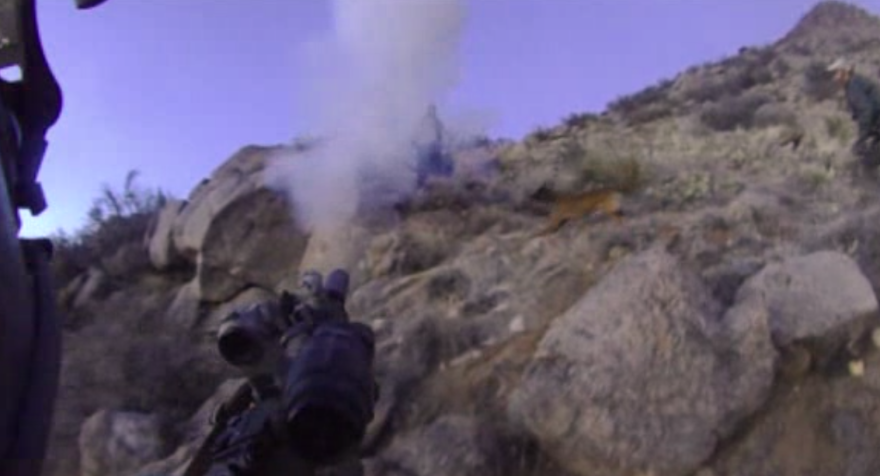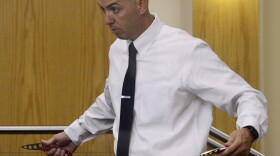For the first time in memory, two former Albuquerque police officers are facing second-degree murder charges for an on-the-job shooting. And their trial is offering a rare glimpse into the mindset of law enforcement in tense situations. Former officer Dominique Perez took the stand in his own defense on Tuesday.
The video at the center of this trial is familiar to people all over the country. It showed police shooting James Boyd, who was homeless and who’d showed signs of mental illness. The video was released by the Albuquerque Police Department days after he died, and it went viral, igniting protests and criticism. That footage came from SWAT officer Perez’ own helmet camera.
In court, he reviewed it with his lawyer, explaining his thinking, his role that day, his job.
Perez said he approached quietly with his rifle, negotiating the side of a hill at the base of the Sandia mountains. Boyd stood on an outcropping of rocks.
"As I’m walking up, I don’t want Mr. Boyd to pay attention to me," he said. "I want him to stay interacting with those officers. And I don’t want to be hampering anything that they have going on with him."
On the video, it looks like Boyd is finally ready to come down after a standoff that lasted hours.
"You would agree with me that you watched Mr. Boyd pick up his belongings, correct?" Luis Robles, Perez' attorney asked him.
"Yes sir," he said.
"What did that tell you about whether Mr. Boyd was surrendering?"
"It didn’t give me any indication that he was surrendering," Perez said. "He hadn’t relinquished his knives."
Boyd assured the police that he was not a murderer. Officers deployed nonlethal force—a distraction device or flash-bang, a Taser shotgun, a dog. Then the K-9 officer takes a couple steps up the incline toward Boyd, who pulls out his knives.
"In my perception," Perez said, "it looked like he was going to come straight down on the officers in a stabbing motion because of the way he pulled the weapons systems out—or excuse me—the knives out from his pockets and took that aggressive fighting stance."
The other defendant, former officer Keith Sandy, fired three bullets, and just a hair later, Perez fired another three.
"You understand today that you ended up shooting Mr. Boyd in the back, correct?" Robles asked.
"As it turns out I did. Yes sir," Perez said.
Perez explained that he was taking in so much stimuli in those moments, and there was a lot to consider all at once as he moved his index finger onto the trigger.
"So as I move from when I made the decision to fire to make sure that I was not going to injure my other officers and moved back, in that fraction of a second, Mr. Boyd had turned," Perez testified.
Then was special prosecutor Randi McGinn’s turn. She did something kind of unorthodox. She didn’t just question Perez.
"It is true that you did not plan or create the failed arrest attempt that happened in the Foothills on March of 2014?" she asked.
"I had no dealings with plan, no," Perez said.
"And I can’t tell you how sorry I am that you are the one who was sent up into a mess that some other officer created," she said.
The defense objected, and the judge sustained that objection.
McGinn continued and confirmed with Perez that police officers are not above the law, and that being a Marine—Perez served in Iraq—wasn’t a free pass.
Then she asked whether Perez had been trained on when homicide by a police officer is justified—for example, when someone is resisting arrest.
"Mr. Boyd was never told he was under arrest was he sir?" McGinn asked.
"Not from the time I was there," Perez said on the stand.
McGinn pointed out that after the shooting, Perez wasn’t treated like an ordinary murder suspect. He had a full two days to cool down before giving his statement and the APD investigator who interviewed him was someone he’d worked with before.
"And Det. Stone conducted a friendly interview, did he not?" McGinn asked.
"It didn’t appear more friendly than normal."
"He let you say whatever you wanted, did he not?"
"He asked the questions, and I answered them."
"In fact on page 2," McGinn pressed, "he said ‘I’m just going to give you the floor, man, and let you run through everything that you did.' Isn’t that what he said, sir?"
"I believe he did, yes ma’am," Perez said.
The prosecution is challenging the effectiveness of the SWAT team in dangerous situations. The defense is trying to show that James Boyd was threatening an officer, and that Sandy and Perez defended him. Testimony continues this week.







